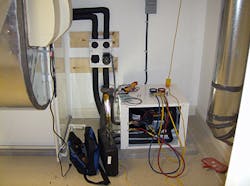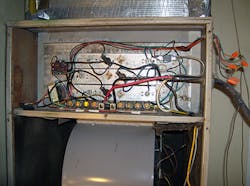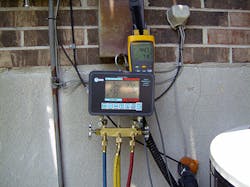As I was growing up in the HVAC industry, my dad offered a lot of wisdom on troubleshooting that I still rely on heavily to this day. One of the things my dad told me was "Know how the individual components in a system are supposed to function and the proper sequence of operations of the equipment you are working on. You have to know what to expect when you turn on the equipment."
The best technicians in this industry won't necessarily have every heat pump wiring schematic and timing sequence memorized, but they do have a firm understanding in the basics of a piece of equipment's operation and its controls. One of the keys to successful troubleshooting of a heat pump is having a firm grasp of the basics of heat pump operation and its controls. Know what to expect next in the sequence of operations. Heat pumps have some controls that're unique such as reversing valves and defrost controls to name a couple. Take time to become familiar with these differences and how they operate and vary between manufacturers.
Things To Be Aware Of
One of the most common mistakes technicians make in troubleshooting a heat pump is to assume they know what the diagnosis is with the limited information received from the dispatcher. They already have the equipment diagnosed and repaired before stepping onsite. When a preconceived diagnosis is formed about the problem before any information or readings have been gathered it can put a set of blinders on that cause you to stumble in locating the real problems. Keep an open mind until you have enough information to make a proper diagnosis of the real problem.
The homeowner interview can give valuable troubleshooting information, as they know their HVAC system better than anyone. Many times the homeowner can give you clues to certain sounds the equipment made that weren't normal, the time of day they noticed their problem occurring, whether the problem is intermittent, or that spike in their utility bill last month. These clues will help you paint a picture in your mind of what has led up to the failure of the system along with other underlying problems that need to be investigated.
Encourage this participation from a homeowner as it can make your life much easier.
If the homeowner informs you that condensate is running all over the basement floor you will naturally proceed with troubleshooting this scenario differently than you would a complaint of no cooling.
The Thermostat – Your First Stop
After your initial walk through if you are unable to get a good feel for where the problem may be isolated from the information in the homeowner interview start at the thermostat. Many thermostats will display fault codes or a diagnostic code for a heat pump that is locked out. These codes can lead you in the right direction and save a lot of unnecessary time. If the thermostat is not equipped with a fault code or diagnostic indicator, turn the fan switch on the thermostat to the "on" position. This one flip of the fan switch yields some valuable information that can be used to shorten the process of elimination in your troubleshooting.
If the fan comes on you will know:
- The air handler or furnace has line voltage to it
- The transformer is operational and putting out 24 volts
- The fan relay is operational and switching contact position
- The indoor fan motor is operational and running
- The fan switch in the thermostat is operational and sending 24 volts to the fan relay coil
Five potential problems can be eliminated in this one quick test if the indoor fan comes on. If the indoor fan does not come on you now have a clue to focus your initial troubleshooting at the air handler or furnace.
If the indoor fan does come on it's now time to turn the thermostat on to energize the equipment to see what is going to occur.
The next steps you take in troubleshooting will be determined by what the equipment does when it’s energized by the thermostat.
In general you'll typically deal with an electrical, refrigeration or airflow problem when it comes to troubleshooting.
When the Heat Pump Won't Run
If all the equipment components don't energize and operate like they should chances are pretty good that you'll be tracking down an electrical problem. Electrical problems will make up a large majority of the issues you'll run into initially. The real causes of many electrical issues are created by more underlying problems in the system itself and can be traced back to poor installation practices. Anytime you find the problem with a heat pump to be tripped circuit breaker, don't rush to immediately reset it.
Determine where you'll be testing to make sure voltage is energizing various controls that may be present. Keep testing until you find the point where voltage is supposed to be present but isn’t found. Once this point is found you need to determine the condition not allowing voltage to proceed whether it's a bad connection, component, open fuse or an open switch.
Airflow and Refrigeration Side Issues
If all the equipment components energize and run, chances are you’ll be moving into troubleshooting some form of an airflow or refrigeration problem.
Check first to see if the equipment is transferring heat. This can be done quickly through a check of the supply air temperature at the equipment or by checking the discharge temperatures at the heat pump itself outside.
If the air temperature circulated by the fan feels close to ambient temperature it's time to hook up a manifold set. Make sure you know the type of refrigerant you're getting ready to work with and purge all the air out of your hoses before attaching them to the system. If the refrigeration side of the system is flat on charge you have some leak searching ahead of you.
If there's a charge in the heat pump obtain your saturation temperatures from the manifold then obtain suction line temperatures and liquid line temperatures to determine the superheat and subcooling of the system. You'll need to refer to the manufacturer’s performance data and the type of metering device that’s installed to determine what these readings need to be. If the superheat and subcooling readings are out of range the next step is going to be to verify proper airflow across the indoor coil. Many times the urge is to start adding refrigerant to a system that appears to be undercharged.
Fight the urge and verify proper airflow before charging a heat pump. It only takes about five minutes to measure static pressure on an air handler and plot the airflow that the fan is moving. You might just surprise yourself as to the other opportunities it uncovers also.
Charging of a heat pump in the cooling mode isn’t much of an issue unless you are experiencing low ambient or low load conditions. Charging a heat pump in the heating mode can be a bit more complicated. To my knowledge if a charge issue is suspected in the heating mode that charge is to be recovered and weighed in per the nameplate data on the equipment according to the manufacturers. Some manufacturers will provide charts to quick check a heating charge but they are not designed to charge accurately in the heating mode.
Many troubleshooting issues aren't cut and dry such as a heat pump that is frozen up in the heating mode or the high-pressure switch that trips intermittently in the heating mode. These problems could be a refrigerant charge issue as well as an issue with the defrost controls in the heat pump or a weak run capacitor on the fan motor. When issues like this are encountered be sure to examine all the possibilities that could lead to this type of an issue and eliminate them as possible causes.
Begin to gather equipment data for the systems you service and start a reference library. There are many sources available online that can assist you in the gathering of this information. You can't have too much information on the equipment you service on a daily basis. By focusing on the details and not forgetting the fundamentals troubleshooting heat pumps becomes just a little less intimidating.
David Richardson serves the HVAC industry as a Curriculum Developer and Trainer at the National Comfort Institute. NCI specializes in training focused on improving, measuring, and verifying HVAC and Building Performance. If you're an HVAC contractor or technician interested in a free NCI Generic Heat Pump Performance Table, contact David at [email protected] or call him at 800-633-7058. NCI’s website www.nationalcomfortinstitute.com is full of free technical articles and downloads to advance your diagnostic capabilities.












